Samsung Galaxy Nexus & Ice Cream Sandwich Review
by Brian Klug & Anand Lal Shimpi on January 18, 2012 1:34 PM ESTCellular
From a cellular perspective there really are two entirely different Galaxy Nexii, as noted before. The GSM/UMTS (maguro) version which is slightly thinner, and the CDMA/LTE (toro) version which is on sale on Verizon at present and no doubt also Sprint later on when their LTE network is fired up. To accommodate those different combinations of air interfaces, Samsung made two very different phones.
GSM/UMTS Galaxy Nexus
| Galaxy Nexus (GSM/UMTS) - Network Support | |||||
| GSM/EDGE Support | 850 / 900 / 1800 / 1900 MHz | ||||
| WCDMA Support | 850 / 900 / 1700 / 1900 / 2100 MHz | ||||
| HSPA Speeds | HSDPA 21.1 (Cat.14) / HSUPA 5.76 (Cat.6) | ||||
| Baseband Hardware | Intel/Infineon X-Gold 626 w/I5712 transciever and RFMD RF6260 PA | ||||
Cellular connectivity on the GSM/UMTS Galaxy Nexus is courtesy of an Infineon/Intel X-Gold 626 (XMM6260). This is the same baseband as what shipped in the GT-I9100 SGS2, which isn’t much of a surprise at all. That means HSPA+ with HSDPA 21.1 (64QAM) and HSUPA 5.76. From a cellular perspective, the Galaxy Nexus is actually virtually identical to the GT-I9100 SGS2, and includes the exact same Infineon Smarti UE2 RF transceiver marked 5712, and the RFMD RF6260 quad-band multi mode (GSM/EDGE and WCDMA) power amp which works between 1710 and 1980 MHz, and 824–915 MHz, supplanting the need for individual power amps for each band. Of course, the 2100 MHz band has its own power amp elsewhere. The GSM/UMTS Galaxy Nexus also takes a regular size Mini SIM (not microSIM). In addition, though XMM6260 supports it, the Galaxy Nexus doesn’t include Rx diversity, and instead just locates its single cellular antenna at the very bottom of the device in one module, and the WLAN antenna off to the side.
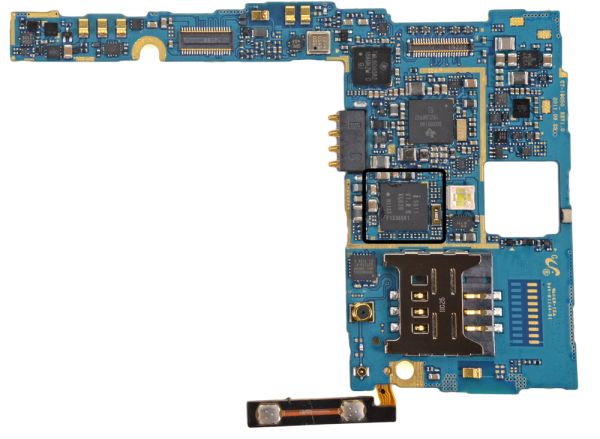
Intel X-Gold 626 circled in black above - Image courtesy iFixit
When the Nexus One (and later Nexus S) originally came out, I was puzzled by why Google hadn’t asked its OEM to include pentaband WCDMA support. Back in the Nexus One days, Google was making its big push to try and reshape the way smartphone shoppers buy phones in the US (and make things more like how the rest of the world does it). At the same time however, the hardware launched effectively only with the WCDMA band support for T-Mobile in the US. Third time is a charm, and the GSM/UMTS Galaxy Nexus is now both the first Nexus phone with pentaband WCDMA support, and, moreover, the only Android phone with pentaband WCDMA. The result is a new level of freedom - fully carrier-unlocked and hardware-unlocked hardware that is finally completely carrier agnostic (at least in GSM/UMTS land).
We tested the GSM/UMTS Galaxy Nexus on T-Mobile’s HSPA+ network and burned through the 2 GB of data on Google’s SIM before burning through another couple of GBs on our own T-Mobile SIM. All in all we ran over 200 tests and generated the histograms that normally grace our smartphone reviews.
T-Mobile HSPA+
Downstream Stats (Mbps) Avg: 3.522; Max: 8.689; Min: 0.029, StDev: 2.022
Upstream Stats (Mbps) Avg: 1.192; Max: 3.259; Min: 0.025, StDev: 0.814
Latency Stats (ms) Avg: 196.93; Max: 500; Min: 105, StDev: 57.122
Number of Tests Run: 244
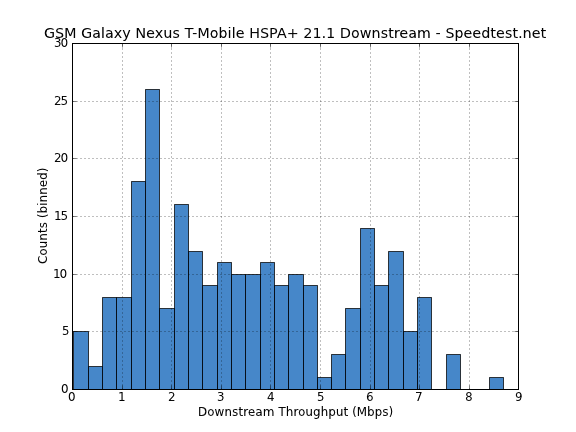
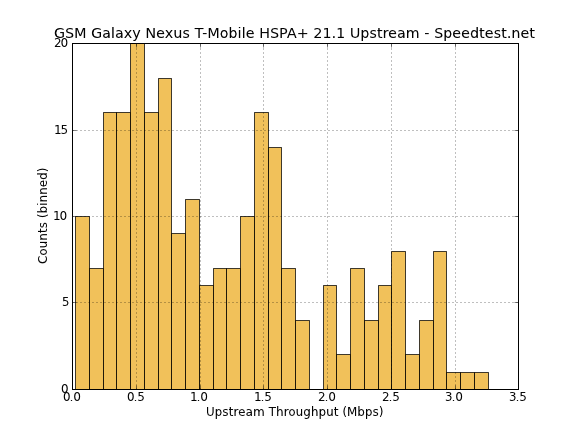
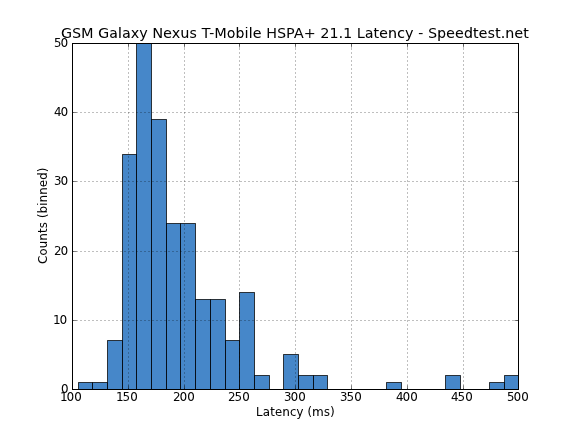
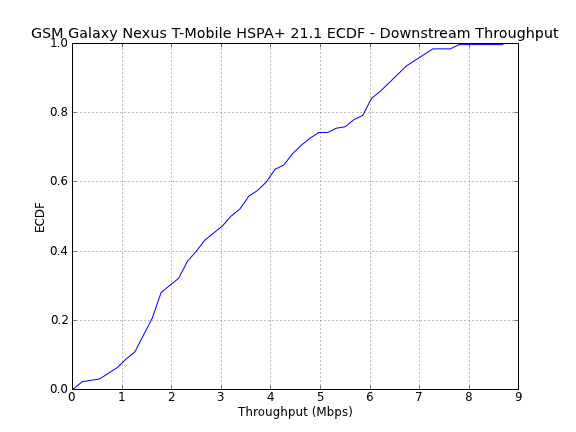

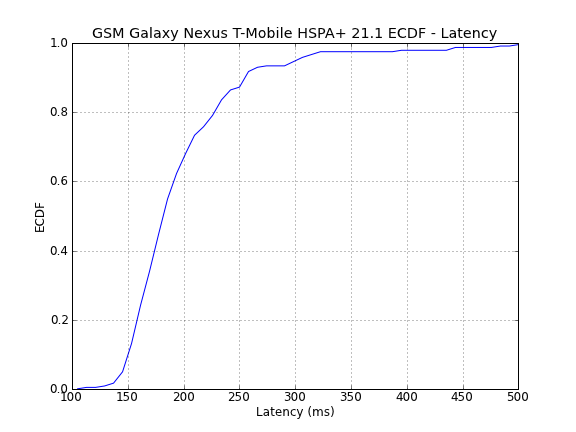
T-Mobile can be fast when it wants to, hitting 8 Mbps down at one point, and 3.2 Mbps up at another. Obviously the Galaxy Nexus is where it should be considering its HSPA+ category. I also tested the GSM/UMTS Galaxy Nexus on AT&T but didn’t run enough tests to generate the most meaningful histograms. I couldn’t get the Galaxy Nexus to go quite as fast as I’d expect it to on AT&T HSPA+ for some reason, even using the “phone” APN.
AT&T HSPA+
Downstream Stats (Mbps) Avg: 2.114; Max: 4.396; Min: 0.083, StDev: 0.979
Upstream Stats (Mbps) Avg: 1.201; Max: 1.681; Min: 0.043, StDev: 0.449
Latency Stats (ms) Avg: 280.479; Max: 951; Min: 107, StDev: 281.045
Number of Tests Run: 71
Oh, and needless to say, the Galaxy Nexus doesn’t suffer from any deathgrip or related signal propagation issues that I can identify.
CDMA/LTE Galaxy Nexus
When I caught wind of the fact that Verizon had also been selected as a launch carrier for the Galaxy Nexus, I speculated that Samsung would reuse the same cellular architecture it used in the Droid Charge. In that review, I talked about how the device used a combination of Samsung CMC220 for LTE, and VIA Telecom’s CBP 7.1 platform for CDMA2000 1x/EVDO. It’s a rather unique combination that also shipped in the Samsung Stratosphere.
| Galaxy Nexus (CDMA/LTE) - Network Support | |||||
| CDMA2000 1x/EVDO Support | EVDO Rev.A (800 / 1900 MHz) | ||||
| CDMA Baseband Hardware | VIA Telecom CBP7.1 with FCI FC7780 | ||||
| LTE-FDD Support | UE Category 3 - 700 MHz Band 13 | ||||
| LTE Baseband Hardware | Samsung CMC221 with FCI FC7851 | ||||
It makes sense for Samsung to reuse what work it has invested in making both Android’s Radio Interface Layer (RIL) and hardware work together for the Galaxy Nexus, and this turned out to be a pretty good educated guess. It turned out mostly correct - the CDMA/LTE Galaxy Nexus is based on a combination of Samsung CMC221 and VIA Telecom CBP 7.1.
_575px.jpg)
_575px.jpg)
Samsung CMC221 and VIA Telecom CBP7.1 - Courtesy ZDnet/TechRepublic
So what’s different between CMC220 and CMC221? No doubt, CMC221 simply is a revision of CMC220 which improves connection stability and handover performance, as one of my few complaints with CMC220 were the prevalence of paused connections in some environments.
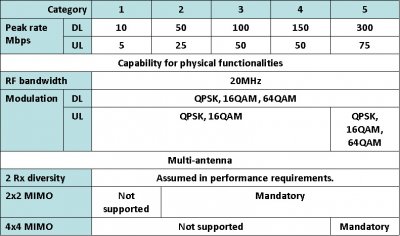
Beyond that, it’s hard to know exactly what’s changed, but suffice it to say CMC221 shares the properties with CMC220 that we care most about. It’s a UE Category 3 part - which is the current maximum for devices right now - it’s no doubt 3GPP Rel.8, and it supports 2x2 MIMO on the downlink. The CDMA/LTE Galaxy Nexus right now only operates on Verizon’s 10 MHz FDD LTE network, though Sprint is slated to get a CDMA/LTE Galaxy Nexus of their very own that will undoubtably be tailored to the 1900 MHz PCS block it deploys in. For now however, we’re just talking about the variant on Verizon 4G LTE.
I ran a bunch of tests on the CDMA/LTE Galaxy Nexus on Verizon 4G LTE and 3G EVDO networks. I tested 4G LTE in my Tucson, AZ market and honestly found using a UE Category 3 device quite refreshing after a long wave of UE Category 2 Motorola Wrigley. There is absolutely a difference in the kind of speeds you can see between devices, and I definitely consider the LTE Galaxy Nexus’s performance above average. I saw a maximum of 58 Mbps on the LTE Galaxy Nexus, though I didn't grab a screenshot. I did of one at 56 Mbps down, however.
Verizon Wireless 4G LTE
Downstream Stats (Mbps) Avg: 19.715; Max: 58.294; Min: 0.089, StDev: 11.744
Upstream Stats (Mbps) Avg: 7.437; Max: 19.711; Min: 0.242, StDev: 3.699
Latency Stats (ms) Avg: 87.312; Max: 188; Min: 63, StDev: 21.285
Number of Tests Run: 342
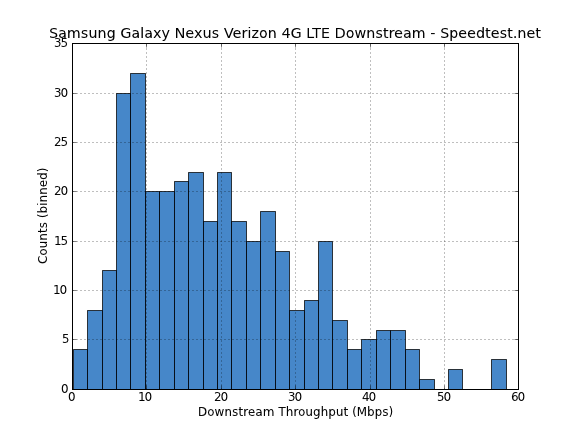
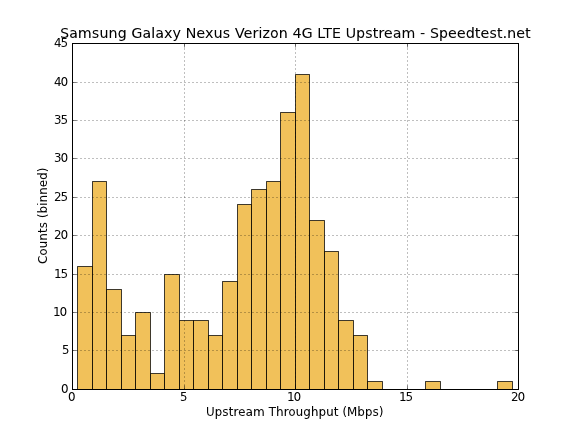
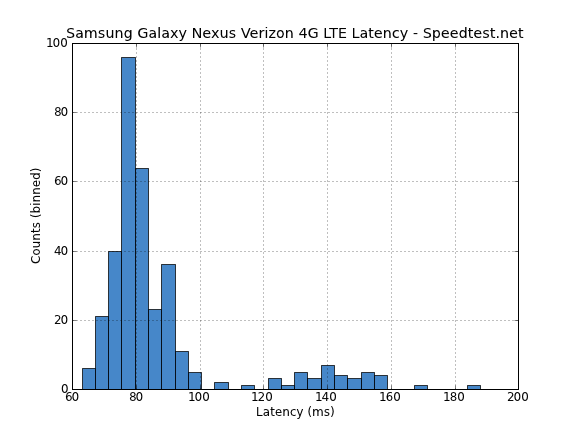

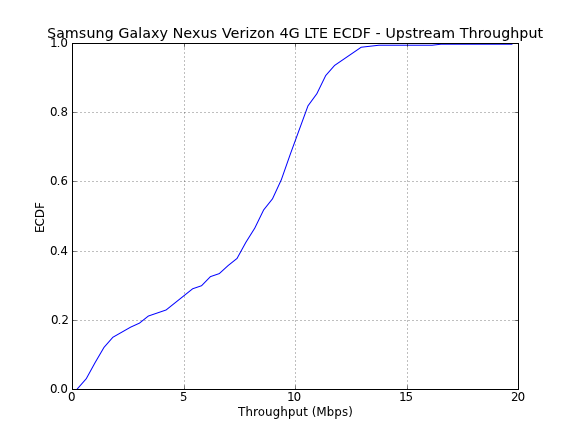

Again, I consider the 4G LTE performance of the Galaxy Nexus quite good, and I saw speeds in my market that I haven’t been able to achieve with other devices. The 58 Mbps test is pretty good, although I know a few other people I talk to have been able to hit over 71 Mbps on the Galaxy Nexus, and likewise consider its RF performance above average on LTE.
We also talked about the perceived LTE signal issue with the Galaxy Nexus at some length. Without revisiting the whole thing, the issue is with the way Android 4.0.2 paints signal bars as a function of signal strength. The Galaxy Nexus as of 4.0.2 does this in a way that isn’t in line with the other Verizon 4G LTE devices, and coupled with the fact that getting to LTE signal strength (and not 1x or EVDO RSSI) is difficult, misled many into thinking there was an issue when there really wasn’t one. I’ve continued comparing LTE RSRP (Reference Signal Received Power) between the Galaxy Nexus and other phones that report it, and have yet to see a significant difference. In addition, other LTE devices reported RSSI instead of RSRP - again it’s good that people are using numerics instead of bars (which are not standardized), however caution must be taken to compare the same parameters properly.
Of course, that’s really not all there is to talk about - what about 1x and EVDO performance on the VIA CBP7.1? My initial investigation only looked at 4G LTE, and since then I’ve had countless people email or otherwise notify me that EVDO also needs a good looking at.
I believe I’ve nailed down why there’s a perception that something is wrong with the Galaxy Nexus’ EVDO connectivity. Interestingly enough, the reason is again a nuance in the way that the device reports signal, but on EVDO. In particular, I noticed something in common with the Droid Charge that is no doubt unique to CBP 7.1. Namely, the baseband reports signal level in a quantized fashion at a few different levels in dBm. Ordinarily I see signal level quantized to just integer values, however on the CBP 7.1 based devices I’ve seen (like the Droid Charge and CDMA Galaxy Nexus) that quantization takes it to a few different levels. That means the values below are the only ones shown when connected to EVDO. You could be in an area with -51 dBm EVDO RSRP, but the maximum you’ll ever see reported is -75. There’s some hysteresis as well and the device doesn’t switch between levels that often.
-75
-83
-93
-100
-113
-120 (0 signal)
I have a sneaking suspicion that these values originally were designed to correspond to some decent cutoffs for signal bars (eg a 5 bar system with -120 being 0 bars), though I’m not entirely certain. The result of this quantization again is that you can be misled into thinking signal is worse or better than it really is depending on conditions, and I wager that this is what leads many to report that things are different than shown on other devices. I also compared EVDO signal strength between the CDMA/LTE Galaxy Nexus and a Droid Bionic, and quantization issues notwithstanding I saw very similar measures.
The caveat is that no doubt CBP 7.1 + FC7780 has different performance than the MDM6600 that has been ubiquitous for CDMA connectivity, so the fact that phones might perform differently in the same location doesn’t surprise me. That said, I’ve yet to see anything dramatic at all.
Nevertheless, I ran a ton of tests on EVDO (eHRPD is EVDO anchored through the PDN-Gateway) to test performance.
Verizon Wireless 3G EVDO Rev.A
Downstream Stats (Mbps) Avg: 0.891; Max: 2.525; Min: 0.07, StDev: 0.560
Upstream Stats (Mbps) Avg: 0.851; Max: 1.534; Min: 0.149, StDev: 0.254
Latency Stats (ms) Avg: 145.036; Max: 800; Min: 103, StDev: 97.1341
Number of Tests Run: 139
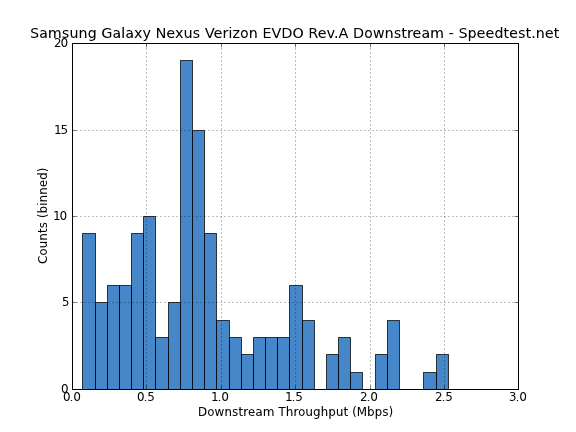
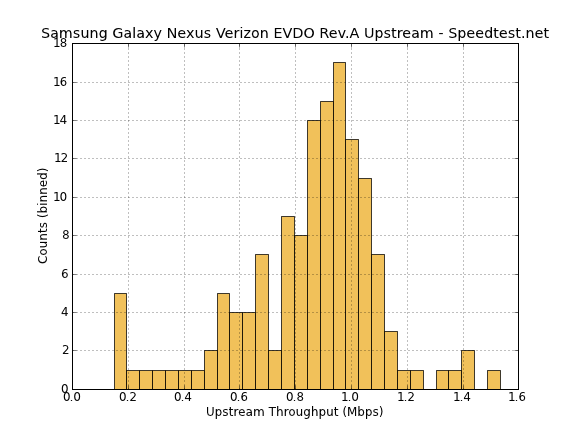
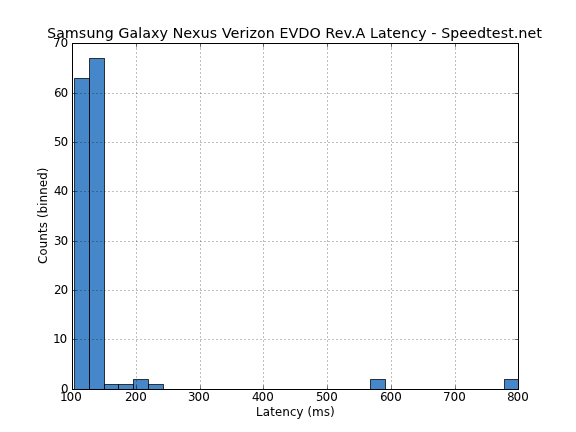



Honestly I can find nothing wrong with EVDO performance on the Galaxy Nexus. In fact, if you go back to the Droid 3 review, you’ll see that the Galaxy Nexus numbers are slightly higher in the upstream department and pretty similar (though differently grouped) on downstream.
Call Quality
I don’t usually include call quality measures in this section, but it also bears talking about since we’re dealing with some reports of things varying from what they’ve seen before on the CDMA/LTE Galaxy Nexus. Call quality on the GSM/UMTS Galaxy Nexus on T-Mobile is pretty par for T-Mobile 3G voice (AMR).
CDMA voice on the Galaxy Nexus does sound a bit different from other devices, however. Compare to the RAZR below which is again based on MDM6600 and its own vocoder.
It isn’t a huge difference, but enough to account for why many people have reported that voice sounds different on the CDMA/LTE Galaxy Nexus. Again, there are bound to be subtle differences between implementations, and I wager Qualcomm’s CDMA market domination in the US accounts for why the difference is something so many have talked about. It’s interesting to me that none of these nuances attracted as much attention with the Droid Charge, but then again I doubt as many people made a switch at that point.
That said, I’ve been using the CDMA/LTE Galaxy Nexus for almost all my calls, and did encounter one circumstance where voice continually cut in and out inexplicably. I haven’t experienced that behavior since.
When it comes to ambient noise suppression, both the CDMA/LTE Galaxy Nexus and GSM/UMTS Galaxy Nexus have a second microphone for common mode noise rejection. The microphone is right near where the battery cover makes contact with the top, slightly offset to the right. It’s a small port but easy enough to pick out.
I don’t know what solution is at play inside the Galaxy Nexus, but it honestly does a mediocre job suppressing noise, we’ve seen other phones definitely do better.


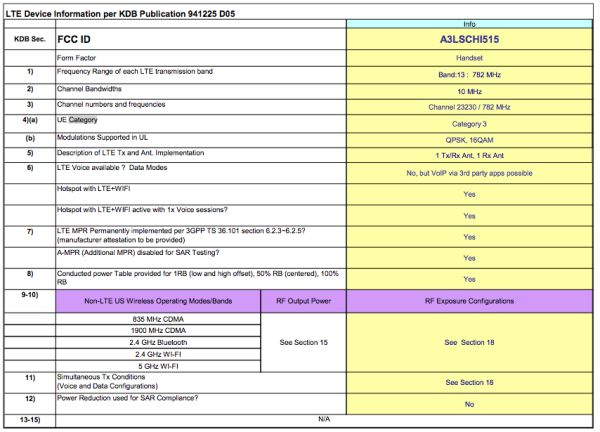









185 Comments
View All Comments
Jingato - Friday, January 20, 2012 - link
Why even bother posting a review of a phone that is over a month old? If you want to be a real news /review site you should of had a review the next day. There is no reason not to. period.get your shit together
tipoo - Friday, January 20, 2012 - link
Because they go more in depth than most reviews out there. The ones that post reviews the day after a product launch don't find nearly as many flaws and details as the AT team. There are plenty of other sites for quickie reviews, I like Anandtech for in-depth.Omid.M - Sunday, January 22, 2012 - link
That's unnecessarily harsh. If you're used to the same day "reviews" of Engadget--i.e. NOTHING technical, totally subjective measurements of everything, in the name of being the "first" with a review--then go ahead and keep reading Engadget.Brian and Anand review EVERYTHING in depth: basebands, screens, software, they even have supercurio who is well known dev in Android community for his take on audio processing. Plus, Anand and Brian were covering CES.
Anand, Brian,
Great job as always. I have a chance to pick up a Nexus LTE for $500 (since I don't have an upgrade) but will hold off; might go with iPhone 4S until Krait or iPhone 5 comes out and (hopefully) blows me away.
-Omid
@moids
Harbler - Sunday, January 22, 2012 - link
Why even bother posting a comment if you're not going to read the review? A cursory perusal of the index alone would have answered your question.Anand & Co. take the time required to turn in top-notch, in-depth reviews, and they've been doing it for longer than your favorite gadget review site has even been in business. Anandtech is, in every sense, a *real* review site.
If wholly subjective reviews of devices (provided within hours of launch) are your idea of informative reading, then please return to Engadget or whatever site you strayed from. Unlike Anadtech, sites of the sort you're looking for are a dime a dozen, and you'll find them substantially better suited to your attention span.
vortmax2 - Friday, January 20, 2012 - link
Can Brian or Anand comment on why they believe Samsung used an OMAP 4460 when they only clocked it to 4430 levels? Also, devs at XDA are having a hard time overclocking it to the 1.5GHz/384MHz max values. Any ideas? Thanks! -JamieTripp1717 - Friday, January 20, 2012 - link
Ive had it for over a month now and i upgraded from a galaxy s (epic 4g on Sprint). Watching Blue ray movies i put on my phone are simply amazing. Ive never seen anything better and i work in the electronics dept at sears. Its better than the samsung 7000 led screen. Overall it took a few weeks to really get used to Andriod 4.02 but it is an amazing improvment from 2.3.5. I cant think of too many flaws here. LTE is SOOO much fater than WiMax! i get about 25-30 MB/s when using speedtest. Upload speeds are very fast too, ave. is around 10ish MB/s. Battery life is fantastic compared to my epic 4g. At work i set my ohone to data restrict so i only get calls and texts because in my store there is NO signal at all and after 8 hours from 100% it will drop to 85%. My Epic wouldnt make it through the work day. 720p Super AMOLED+ really makes this phone a winner. Google and samsung working together is a great combo. My ONLY complaint is i wish i had an 8 or higher megapixel camera. But with the added features its pretty darn decent. No complaints except there are a few programs that are still not compatible with 4.0+ (HBOGO). I highly recomend this over any phone out or anything slated to come out for awhile anyways.Amit P - Friday, January 20, 2012 - link
I'm waiting for my THIRD Nexus to come in. I had screen problems with the first two. The screen wasn't as bright as my brothers Nexus with the same settings. The colors weren't as vivid either.Bristecom - Friday, January 20, 2012 - link
Thats why I didnt exchange mine. Even though it has a dead pixel, aside from that, the screen looks great. So I fear getting one with no dead pixels but poor brightness or colors. This screen is the best Ive ever seen. Other super AMOLED plus displays Ive seen have off colors that bother me.Bristecom - Friday, January 20, 2012 - link
I have to say, mine has a dead green subpixel and it is very clear to me even from a distance with green or white screens. Regardless, I didnt bother exchanging it. -Sent from my Galaxy Nexusmedi01 - Saturday, January 21, 2012 - link
A question, I have Galaxy S so can't compare.Could you please comment on whether black is actually black on Nexus as it is on Galaxy's?
I'm asking because dear objective Anand managed to make a photo of it that makes it look gray ("Display" page)